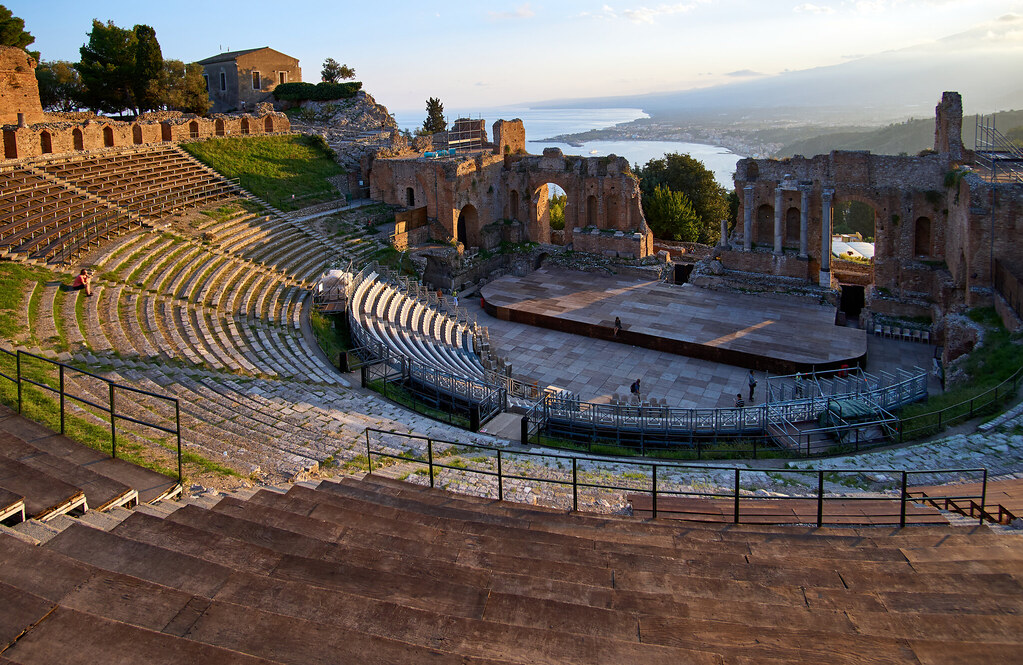Historic Landmarks of Sicily
Sicily is an island located off the southern coast of Italy, and is known for its rich cultural heritage and historic landmarks. Here is a short overview of some of the most notable historic landmarks in Sicily.

Cathedral of Monreale
The Cathedral of Monreale is one of the greatest existent examples of Norman architecture. The construction of Monreale, started in 1172, was approved by Pope Alexander III with a bull on 30 December 1174. Works, including an annexed abbey, were completed only in 1267 and the church consecrated at the presence of Pope Clement IV.
Read more about Cathedral of Monreale
Greek Theatre of Taormina
Teatro antico di Taormina is an ancient Greek theatre in Taormina, built in the third century BC.
Read more about Greek Theatre of Taormina
Palermo Cathedral
Palermo Cathedral was erected in 1185 by Walter Ophamil (or Walter of the Mill), the Anglo-Norman archbishop of Palermo and King William II"s minister, on the area of an earlier Byzantine basilica. By all accounts this earlier church was founded by Pope Gregory I and was later turned into a mosque by the Saracens after their conquest of the city in the 9th century.
Read more about Palermo Cathedral
Norman Palace
The Palazzo dei Normanni (Norman Palace) was the seat of the Kings of Sicily during the Norman domination and served afterwards as the main seat of power for the subsequent rulers of Sicily. The building is the oldest royal residence in Europe; and was the private residence of the rulers of the Kingdom of Sicily and the imperial seat of Frederick II and Conrad IV.
Read more about Norman Palace
Cefalù Cathedral
The Cathedral of Cefalù is one of nine structures included in the UNESCO World Heritage Site known as Arab-Norman Palermo and the Cathedral Churches of Cefalù and Monreale. The cathedral was erected between 1131 and 1240 in the Norman architectural style, the island of Sicily having been conquered by the Normans in 1091.
Read more about Cefalù Cathedral
Villa Romana del Casale
The Villa Romana del Casale is a large and elaborate Roman villa or palace located about 3 km from Piazza Armerina.
Read more about Villa Romana del Casale
Segesta Temple
Segesta was one of the major cities of the Elymians, one of the three indigenous peoples of Sicily. The hellenization of Segesta happened very early and had a profound effect on its people. On a hill just outside the site of the ancient city of Segesta lies an unusually well preserved Doric temple.
Read more about Segesta Temple
Ursino Castle
Castello Ursino was built between 1239 and 1250, as one of the royal castles of Emperor Frederick II, King of Sicily. In 1295, during the Sicilian Vespers, the Parliament which declared deposed James II of Aragon as King of Sicily, replacing him with Frederick III, was held here.
Read more about Ursino Castle
Necropolis of Pantalica
The Necropolis of Pantalica is a collection of cemeteries with rock-cut chamber tombs in southeast Sicily. Dating from the 13th to the 7th centuries BC., there was thought to be over 5,000 tombs, although the most recent estimate suggests a figure of just under 4,000.
Read more about Necropolis of Pantalica